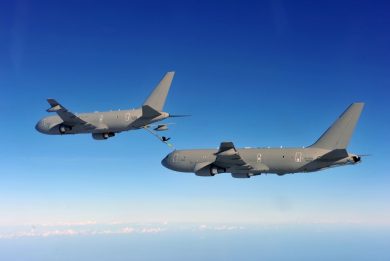
Standardising the Osprey
Definitely the most innovative vertical take-off and landing aircraft produced in the past years by Boeing, together with Bell, is the Osprey, the tilt-rotor aircraft that flew for the first time 40 years ago, in March 1989. A new concept, the V-22 needed some time to reach the required reliability, and it was deployed over 25 years after its maiden flight, however it is now a fully combat proven machine. “There are now over 360 Ospreys operating with the US Marine Corps and Air Force, and they have totalled over 450,000 flight hours, the delivery of the first one to the US Navy being planned in Q3 2019,” Rick Lemaster, Director Global Sales and Marketing at Boeing Defense Systems International Programs says.

The assembly line at Philadelphia produced until now only airframes, which were then sent to Amarillo, Texas, at the Bell Helicopter Textron facility, to be coupled with wings and to have engines and rotors installed. The assembly line was recently moved from the northern side to the southern side of Boeing’s facility in Pennsylvania and is now hosted in Building 3-57.1, recently renovated with an investment of 100 million US$. For the first time Philadelphia will see complete Ospreys leaving the line: the constant evolution of the V-22 led the US Marine Corps to bring all Block B aircraft to the same configuration, in order to reduce logistic and training issues. Known as CC RAM (Common Configuration Readiness And Modernization), it will take those aircraft to a certain Block C configuration, identified by one of the latest Ospreys delivered, evolution continuing. In mid-May three Block B were present on the lines and were being upgraded wile a fourth had arrived a few days earlier. “We will deliver the first CC RAM aircraft before year end,” says Lemaster. Overall 129 Block B should undergo CC RAM over a 5+ years timeframe, while it is not clear if Block A aircraft can and will be submitted to the upgrade.

Two lines are now dedicated to the CC RAM programme while one continues producing airframes, although at a slower pace in order to extend the line activity; currently 1.5 fuselages per months are produced, compared to three some time ago, this ensuring two more years of work. “We are looking at new orders,” Lemaster says, “and we consider 12 potential international customers, while the number of V-22s ordered by the US military might also increase.” To ensure those possible orders to link-up with the current production, Letters of Authorisation must be filed by Q3 2020, all export orders coming through the Foreign Military Sales pipeline, the prime customer being thus the US Navy.
Boeing looks with interest at F-35B users, as the V-22 is capable to ferry on board a power module with no shock due to hard landing on an aircraft carrier. The Osprey compatibility has been demonstrated on a number of foreign naval platforms belonging to the navies of France, the Netherlands, South Korea, Spain, and the United Kingdom.
Numerous studies were carried out for weaponising the Osprey, a chin gun was developed while rocket pods were also considered. Sonobuoys data linked to an on-board console for anti-submarine warfare missions as well as weapons installed on the ramp or integrated in the fuselage, also for antisurface missions, were taken in consideration, as well as a radar version with a sensor mounted under the ramp, but for the time being the US Navy is concentrating on the long-range resupply version. “We are however talking with the Navy on possible future configurations,” Rick Lemaster concludes.
Photos courtesy Boeing



